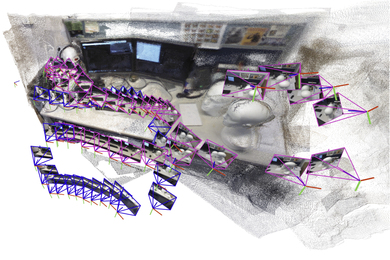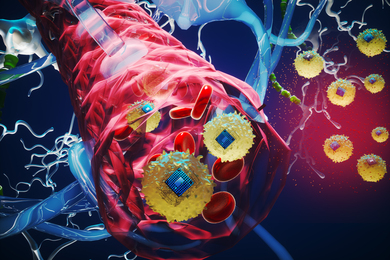Professors Elizabeth M. Nolan and Jeremiah Johnson shared their efforts to address some of the greatest challenges currently faced by the chemical sciences at a recent Alumni and Friends reception hosted by the Department of Chemistry and the School of Science. Invited guests gathered in the Samberg Conference Center on May 16 for an evening of food, drink, and stimulating talks.
Employing metal withholding to inhibit microbial colonization
Nolan’s research addresses the chemistry and biology of human innate immunity and microbial pathogenesis. The lab employs toolkits of biological chemistry, inorganic chemistry, and microbiology to decipher the interplay between human host-defense molecules and microbes, and to evaluate new strategies for treating and preventing microbial infections. A significant portion of the research program is focused on metals and immunity.
Because transition metal ions are essential nutrients for all organisms, metal withholding is one strategy that the mammalian host employs to inhibit microbial colonization. At sites of infection, the host innate immune system deploys metal-sequestering proteins to capture inorganic nutrients (magnesium, iron, and zinc, for example) in the extracellular space and starve invading pathogens. This immune mechanism presents a fascinating problem in biological coordination chemistry and metal homeostasis with central importance to infectious disease. Nolan shared her findings on the effectiveness of human calprotectin (CP) in the metal-withholding innate immune response.
CP is produced by neutrophils and can constitute more than 40 percent of total cytoplasmic protein in these cells. Neutrophils are white blood cells that are recruited to sites of infection and contribute to innate immunity, and they release CP and many other antimicrobial biomolecules into the extracellular space. Following release from the neutrophil, CP chelates transition metal ions in the extracellular milieu, thereby starving bacteria of these nutrients. In addition to this accepted role in the host/pathogen interaction, CP is implicated in a variety of pathophysiological conditions that range from cardiovascular disease to cancer, and it is a U.S. Food and Drug Administration-approved biomarker for inflammatory conditions of the bowel. Thus, molecular and functional insights about CP also provide a foundation for conceptualizing and evaluating how CP participates in these facets of human disease.
Research conducted in Nolan’s lab has revealed many new aspects about how CP functions in metal homeostasis and host defense. She presented vignettes from her group’s fundamental research that highlighted advances towards elucidating the biological coordination chemistry of CP, deciphering how CP affects metal homeostasis in two microbial pathogens, and understanding the lifetime and fate of CP in the biological milieu.
“We discovered that CP uses Ca(II) ions to modulate its coordination chemistry, antimicrobial activity, and proteolytic stability,” Nolan explained. The group also deciphered how CP sequesters first-row transition metals, which included the evaluation of an unprecedented biological coordination motif.
“Contrary to the accepted dogma, we discovered that CP is an iron-sequestering protein that blocks microbial acquisition of this essential nutrient,” Nolan said.
This paradigm-changing result adds another layer of complexity to the interplay between CP and transition metals in biological systems and affords a new model in which CP contributes to iron homeostasis. Subsequently, Nolan’s group has uncovered that CP also sequesters nickel, a metal nutrient important for the virulence of human pathogens that infect the gastrointestinal and urinary tracts. In total, this research program affords paradigms for discovering and elucidating new bioinorganic chemistry, advancing fundamental understanding of human innate immunity and microbial pathogenesis, and achieving new approaches to combating infectious disease. It highlights how fundamental chemistry can be used to open up new doors for exploring and understanding complex biological systems.
“I am fascinated by chemistry and biology and the natural world,” Nolan said. “I am inspired to use the chemistry toolkit to learn more, at the molecular level, about living systems, health, and disease. Studying the bioinorganic chemistry of the host/microbe interaction and infectious disease interfaces concepts and toolkits from many different disciplines and provides opportunities to contribute out-of-the-box ideas both for fundamental research and non-traditional ways to approach the prevention and treatment of infectious disease.”
New synthetic strategies for macromolecules
Just as natural-products chemists must often invent new reaction methodologies to access complex structures and their corresponding derivatives, Professor Jeremiah Johnson’s group seeks to develop new methodologies for the construction and modification of complex material libraries. Iterative library synthesis, function-based screening, and design optimization will ultimately yield basic knowledge, such as structure-function relationships for materials in specific applications, and new materials-based technologies that outperform current alternatives. Some examples of target material platforms and their associated applications are: novel, nanoscopic branched-arm star polymer architectures for in vivo drug delivery and supported catalysis; hybrid synthetic-natural hydrogels for correlation of the effects of network microstructure on cell response; and new types of semiconducting organometallic polymers and polymer films for sensing, supported catalysis, and energy conversion.
“I am inspired by thinking creatively in the context of macromolecular synthesis, and then by seeing initial creations become reality via working with the awesome members of my group,” Johnson said. “Seeing our chemistry translate into commercial uses, such as helping patients, is the dream.”
Johnson presented his group’s efforts to develop a drug-agnostic materials platform that can enable the rapid improvement of therapeutic index for drugs with known targets and established efficacy but poor safety profiles.
“Accomplishing this goal would allow us to rescue drugs that are stalled in early clinical trials due to unmanageable side effects, or to utilize already approved drugs in new ways,” he explained.
One of the major challenges in chemical science is the development of methods and strategies for the controlled and scalable synthesis of large molecules, which are also known as macromolecules. Johnson’s research is driven by the desire to address this challenge and overcome it.
“We synthesize large abiotic molecules with improved structural control at the molecular level, which ultimately translates into new function at the macroscopic level,” he said. “In addition, we focus a lot of our efforts on making these synthetic approaches scalable.”
Johnson’s presentation demonstrated a new synthetic strategy that can enable the kilo-scale synthesis of macromolecular prodrug scaffolds with tunable size and drug release kinetics. These materials can be employed to treat diseases ranging from cancer to liver fibrosis.
Celebrating basic science
Department head Timothy F. Jamison said the Department of Chemistry was pleased to co-host its third annual Alumni and Friends reception with the School of Science. As in years past, this event proved to be an excellent opportunity to showcase a sampling of the revolutionary work being conducted within the halls of the Department of Chemistry and, further still, the MIT campus as a whole.
“I cherish any opportunity I get to hear my colleagues present their research,” Jamison said in his closing remarks. “I am especially delighted that you were able to join us this evening to meet professors Nolan and Johnson and to learn about their spectacular scientific advances. Nolan and Johnson are representative of the extremely high caliber of research in the Department of Chemistry.”










